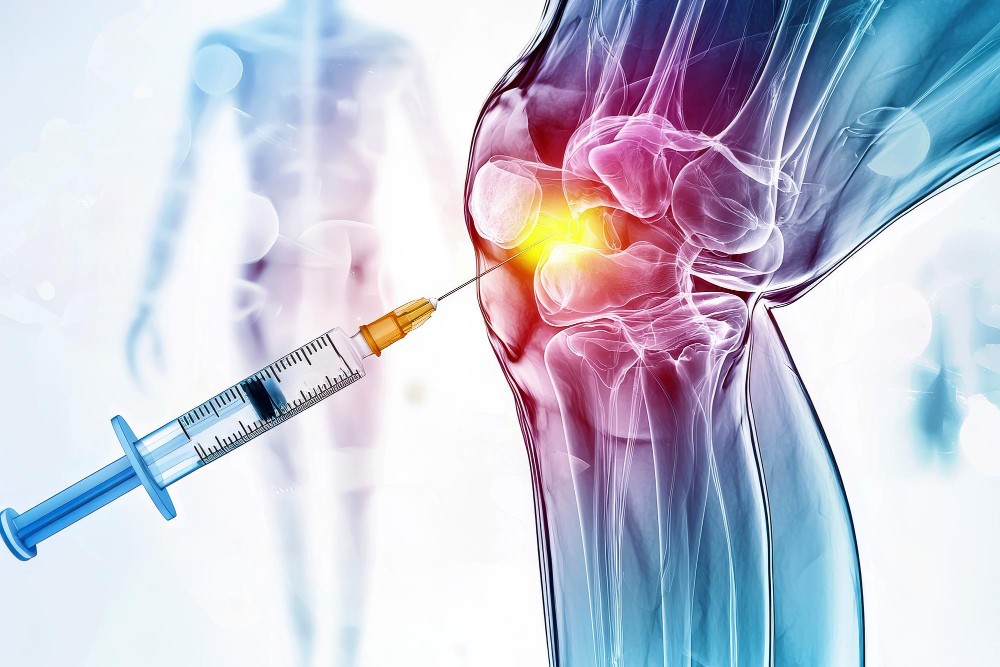WHAT IS OSTEOARTHRITIS?
- Osteoarthritis is the most common chronic disease of the cartilage. As cartilage breaks down due to wear and tear and/or mechanical stress, it leads to swelling, pain, and inflammation, resulting in a loss of extracellular matrix (ECM).¹
- Osteoarthritis is a progressive joint disease that often affects intra- and periarticular structures² and is considered a pathology characterized by articular cartilage lesions, synovitis, subchondral sclerosis, and osteophytes.³
- Osteoarthritis is usually a slowly progressive joint disease characterized by cartilage degeneration and inflammation.⁴
- Knee osteoarthritis often leads to knee pain and limits patients' mobility. Pain in osteoarthritis is generally associated with physical activity. For knee osteoarthritis, activities such as climbing stairs, standing up, and prolonged walking cause pain. Morning stiffness usually lasts less than 30 minutes. Patients often notice their knees "giving way," a symptom known as instability.
WHAT ARE THE RISK FACTORS FOR OSTEOARTHRITIS?
- Age is one of the biggest risk factors 7
- Biological age-related changes in joint structures 7
- Triggers for knee OA in women: Overweight 8
- (Knee OA) 8 Previous knee injuries (Knee OA) - Knee malalignment (Knee OA) 9,10
- Weakness of the knee extensor muscles (Knee OA) 11
- am deformity and mild dysplasia (especially in middle-aged individuals (55-65 years), but not in the elderly population (over 65 years)) (Hip OA) 12
- Severe dysplasia (Hip OA) (OA)= Osteoarthritis
WHAT IS INTRA-ARTICULAR INJECTION?
Hyaluronic acid is an important component of synovial fluid and cartilage and is responsible for joint lubrication and support. It reduces friction between joint surfaces and protects soft tissues from trauma by acting as a shock absorber.
Hyaluronic acid also has analgesic, anti-inflammatory, and antioxidant effects, stimulates proteoglycan synthesis, and facilitates the removal of cartilage debris.
This high-quality hyaluronic acid is produced according to the European Pharmacopoeia.
With our brand Welux, we combine these benefits in the form of an injection for a better quality of life.
REFERENCES
- R. Altman, E. Asch, D. Bloch, G. Bole, D. Borenstein, K. Brandt, W. Christy, T.D. Cooke, R. Greenwald, M. Hochberg, et al., Development of criteria for the classification and reporting of osteoarthritis. Classification of osteoarthritis of the knee, Diagn. Ther. Crit. Commit. Am. Rheum. Assoc. Arthritis Rheum. 29 (8) (1986) 1039–1049.
- Lane NE, Brandt K, Hawker G, et al. OARSI-FDA initiative: Defining the disease state of osteoarthritis. Osteoarthritis Cartilage 2011;19(5):478–82.
- Su K, Bai Y, Wang J, et al. Comparison of hyaluronic acid and PRP intra-articular injection with combined intra-articular and intraosseous PRP injections to treat patients with knee osteoarthritis. Clin Rheumatol 2018;37(5):1341–50.
- Cheng OT, Souzdalnitski D, Vrooman B, Cheng J. Evidence-Based Knee Injections for theManagement of Arthritis. Pain Med (United States). 2012;13(6):740-753.
- Guccione A, Felson D, Anderson J et al. The effects of specific medical conditions on the functional limitations of elders in the Framingham Study. American Journal of Public Health. 1994;84(3):351-358.
- Altman R, Asch E, Bloch D, et al. Development of criteria for the classification and reporting of osteoarthritis. Arthritis Rheum 1986;29:1039-49.
- Zhang Y, Jordan JM. Epidemiology of osteoarthritis. Rheum Dis Clin North Am 2008; 34: 515–29.
- Silverwood V, Blagojevic-Bucknall M, Jinks C, Jordan JL, Protheroe J, Jordan KP. Current evidence on risk factors for knee osteoarthritis in older adults: a systematic review and meta analysis. Osteoarthritis Cartilage 2015; 23: 507–15.
- Brouwer GM, van Tol AW, Bergink AP, et al. Association between valgus and varus alignment and the development and progressio of radiographic osteoarthritis of the knee. Arthritis Rheum 2007; 56: 1204–11.
- Runhaar J, van Middelkoop M, Reijman M, Vroegindeweij D, Oei EH, Bierma-Zeinstra SM. Malalignment: a possible target for prevention of incident knee osteoarthritis in overweight and obese women. Rheumatology (Oxford) 2014; 53: 1618–24.
- Oiestad BE, Juhl CB, Eitzen I, Thorlund JB. Knee extensor muscle weakness is a risk factor for development of knee osteoarthritis. A systematic review and meta-analysis. Osteoarthritis Cartilage 2015;23: 171–77.
- Gala L, Clohisy JC, Beaulé PE. Hip dysplasia in the young adult Bone Joint Surg Am 2016; 98: 63–73.
- Hunter, David J et al. “The symptoms of osteoarthritis and the genesis of pain.” Rheumatic diseases clinics of North America vol. 34,3 (2008): 623-43. doi:10.1016/j.rdc.2008.05.004
- (M. Hemshekhar, R.M. Thushara, S. Chandranayaka, L.S. Sherman, K. Kemparaju, K.S. Girish, Emerging roles of hyaluronic acid bio scaffolds in tissue engineering and regenerative medicine, Int. J. Biol. Macromol. 86 (2016) 917– 928. doi:10.1016/j.ijbiomac.2016.02.032.)
- Altman RD, Bedi A, Karlsson J, Sancheti P, Schemitsch E. Product Differences in Intraarticular Hyaluronic Acids for Osteoarthritis of the Knee. Am J Sports Med. 2015.
- Pereira H, Sousa DA, Cunha A, Andrade R, Espregueira-Mendes J, Oliveira JM, Reis RL. Hyaluronic Acid. Adv Exp Med Biol. 2018;1059:137-153. doi: 10.1007/978-3-319-76735- 2_6. PMID: 29736572.
 English
English
 Deutsch
Deutsch


